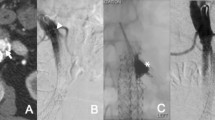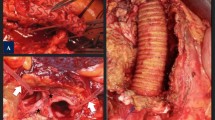Abstract
Purpose
The exact significance of type 2 endoleaks (T2ELs) and the indication and efficacy of treatment are widely debated. We report our experience with managing T2ELs in a tertiary Asian centre.
Materials and Methods
This was a retrospective study of patients who underwent endovascular abdominal aortic aneurysm repair (EVAR) between February 2006 and December 2016. Patients with T2ELs were identified, and their data were analysed.
Results
A total of 156 patients underwent EVAR, of which 67 (42.9%) developed T2ELs. Seven were lost to follow-up. The remaining 60 patients had a mean follow-up period of 50.3 ± 33.9 months—34 (56.7%) experienced T2ELs early and the rest (43.3%) had late T2ELs. Forty-one patients had isolated T2EL, whilst 19 had concomitant T1EL and/or T3EL. Spontaneous resolution occurred in 25 patients (41.7%). All T2ELs with stable sac size were on continued surveillance. Amongst those with persistent T2ELs associated with sac growth (n = 17), 14 underwent intervention, of which 7 (50%) received > 1 embolisation procedure. A total of 16 transarterial embolisation and 8 translumbar embolisation procedures were performed. Technical success rate was 75%. In the intervention group, 5 (35.7%) had complete and sustained resolution, 7 had persistent/recurrent T2ELs but stable sac size, and 2 had progressive sac expansion. Overall mortality due to sac rupture occurred in 2 patients with concomitant T2EL and T1EL/T3EL.
Conclusion
T2ELs are common, albeit mostly benign if occurring in isolation and not in association with sac growth. Achieving complete T2EL resolution with embolisation is difficult even with reinterventions.
Level of Evidence
Level 2B, retrospective study




Similar content being viewed by others
References
Collaborators. Endovascular aneurysm repair versus open repair in patients with abdominal aortic aneurysm (EVAR trial 1): randomised controlled trial. Lancet. 2003;365:2179–86. https://doi.org/10.1016/s0140-6736(05)66627-5.
Lederle FAM, Freischlag JAM, Kyriakides TCP, Padberg FTM, Matsumara JSM, Kohler TRM, et al. Outcomes following endovascular vs open repair of abdominal aortic aneurysm. J Am Med Assoc. 2009;302:1535–42. https://doi.org/10.1001/jama.2009.1426.
Prinssen M, Verhoeven ELG, Buth J, Cuypers PWM, van Sambeek MRHM, Balm R, et al. A randomized trial comparing conventional and endovascular repair of abdominal aortic aneurysms. N Engl J Med. 2004;351:1607–18. https://doi.org/10.1056/NEJMoa042002.
Patel R, Sweeting MJ, Powell JT, Greenhalgh RM. Endovascular versus open repair of abdominal aortic aneurysm in 15-years’ follow-up of the UK endovascular aneurysm repair trial 1 (EVAR trial 1): a randomised controlled trial. Lancet. 2016;388:2366–74. https://doi.org/10.1016/S0140-6736(16)31135-7.
Lederle FA, Freischlag JA, Kyriakides TC, Matsumura JS, Padberg FT, Kohler TR, et al. Long-term comparison of endovascular and open repair of abdominal aortic aneurysm. N Engl J Med. 2012;367:1988–97. https://doi.org/10.1056/NEJMoa1207481.
Patel R, Powell JT, Sweeting MJ, Epstein DM, Barrett JK, Greenhalgh RM. The UK endovascular aneurysm repair (EVAR) randomised controlled trials: long-term follow-up and cost-effectiveness analysis. Health Technol Assess (Rockv). 2018. https://doi.org/10.3310/hta22050.
Choke E, Thompson M. Endoleak after endovascular aneurysm repair: current concepts. J Cardiovasc Surg (Torino). 2004;45:349–66.
Gelfand DV, White GH, Wilson SE. Clinical significance of type II endoleak after endovascular repair of abdominal aortic aneurysm. Ann Vasc Surg. 2006;20:69–74. https://doi.org/10.1007/s10016-005-9382-z.
Rayt HS, Sandford RM, Salem M, Bown MJ, London NJ, Sayers RD. Conservative management of type 2 endoleaks is not associated with increased risk of aneurysm rupture. Eur J Vasc Endovasc Surg. 2009;38:718–23. https://doi.org/10.1016/j.ejvs.2009.08.006.
Pippin K, Hill J, He J, Johnson P. Outcomes of type II endoleaks after endovascular abdominal aortic aneurysm (AAA) repair: a single-center, retrospective study. Clin Imaging. 2016;40:875–9. https://doi.org/10.1016/j.clinimag.2016.04.004.
Sidloff DA, Gokani V, Stather PW, Choke E, Bown MJ, Sayers RD. Editor’s choice—type II endoleak: conservative management is a safe strategy. Eur J Vasc Endovasc Surg. 2014;48:391–9. https://doi.org/10.1016/j.ejvs.2014.06.035.
Karthikesalingam A, Thrumurthy SG, Jackson D, Choke E, Sayers RD, Loftus IM, et al. Current evidence is insufficient to define an optimal threshold for intervention in isolated type II endoleak after endovascular aneurysm repair. J Endovasc Ther. 2012;19:200–8. https://doi.org/10.1583/11-3762R.1.
Jones JE, Atkins MD, Brewster DC, Chung TK, Kwolek CJ, LaMuraglia GM, et al. Persistent type 2 endoleak after endovascular repair of abdominal aortic aneurysm is associated with adverse late outcomes. J Vasc Surg. 2007;46:1–8. https://doi.org/10.1016/j.jvs.2007.02.073.
Wyss TR, Brown LC, Powell JT. Rate and predictability of graft rupture after endovascular and open abdominal aortic aneurysm repair: data from the EVAR trials. J Vasc Surg. 2011;53:1158. https://doi.org/10.1016/j.jvs.2011.02.037.
Moll FL, Powell JT, Fraedrich G, Verzini F, Haulon S, Waltham M, et al. Management of abdominal aortic aneurysms clinical practice guidelines of the European society for vascular surgery. Eur J Vasc Endovasc Surg. 2011. https://doi.org/10.1016/j.ejvs.2010.09.011.
Chaikof EL, Brewster DC, Dalman RL, Makaroun MS, Illig KA, Sicard GA, et al. SVS practice guidelines for the care of patients with an abdominal aortic aneurysm: executive summary. J Vasc Surg. 2009;50:880–96. https://doi.org/10.1016/j.jvs.2009.07.001.
Ultee KHJ, Büttner S, Huurman R, Bastos Gonçalves F, Hoeks SE, Bramer WM, et al. Editor’s choice—systematic review and meta-analysis of the outcome of treatment for type II endoleak following endovascular aneurysm repair. Eur J Vasc Endovasc Surg. 2018;56:794–807. https://doi.org/10.1016/j.ejvs.2018.06.009.
Le TB, Park KM, Jeon YS, Hong KC, Cho SG. Evaluation of delayed endoleak compared with early endoleak after endovascular aneurysm repair. J Vasc Interv Radiol. 2018;29:203–9. https://doi.org/10.1016/j.jvir.2017.09.023.
Silverberg D, Baril DT, Ellozy SH, Carroccio A, Greyrose SE, Lookstein RA, et al. An 8-year experience with type II endoleaks: natural history suggests selective intervention is a safe approach. J Vasc Surg. 2006;44:453–9. https://doi.org/10.1016/j.jvs.2006.04.058.
Ajalata M, Williamsa R, Wilsona SE. The natural history of type 2 endoleaks after EVAR justifies conservative management. J Vasc Endovasc Surg. 2017;02:1–6. https://doi.org/10.21767/2573-4482.100067.
Sidloff DA, Stather PW, Choke E, Bown MJ, Sayers RD. Type II endoleak after endovascular aneurysm repair. Br J Surg. 2013;100:1262–70. https://doi.org/10.1002/bjs.9181.
Nakai M, Ikoma A, Sato H, Sato M, Nishimura Y, Okamura Y. Risk factors associated with late aneurysmal sac expansion after endovascular abdominal aortic aneurysm repair. Diagn Interv Radiol. 2015;21:195–201. https://doi.org/10.5152/dir.2014.14308.
Sarac TP, Gibbons C, Vargas L, Liu J, Srivastava S, Bena J, et al. Long-term follow-up of type II endoleak embolization reveals the need for close surveillance. J Vasc Surg. 2012;55:33–40. https://doi.org/10.1016/j.jvs.2011.07.092.
Gallagher KMA. Midterm outcomes after treatment of type II endoleaks associated with aneurysm sac expansion. J Endovasc Ther. 2012;2012(19):182–92. https://doi.org/10.1583/1545-1550-19.3.A6.
Baum RA, Carpenter JP, Golden MA, Velazquez OC, Clark TWI, Stavropoulous SW, et al. Treatment of type 2 endoleaks after endovascular repair of abdominal aortic aneurysms: comparison of transarterial and translumbar techniques. J Vasc Surg. 2002;35:23–9. https://doi.org/10.1067/mva.2002.121068.
Solis MM, Ayerdi J, Babcock GA, Parra JR, McLafferty RB, Gruneiro LA, et al. Mechanism of failure in the treatment of type II endoleak with percutaneous coil embolization. J Vasc Surg. 2002;36:485–91. https://doi.org/10.1067/mva.2002.126542.
Kasirajan K, Matteson B, Marek JM, Langsfeld M. Technique and results of transfemoral superselective coil embolization of type II lumbar endoleak. J Vasc Surg. 2003;38:61–6. https://doi.org/10.1016/S0741-5214(02)75467-0.
van Marrewijk CJ, Fransen G, Laheij RJF, Harris PL, Buth J. Is a type II endoleak after EVAR a Harbinger of risk? Causes and outcome of open conversion and aneurysm rupture during follow-up. Eur J Vasc Endovasc Surg. 2004;27:128–37. https://doi.org/10.1016/j.ejvs.2003.10.016.
Acknowledgements
Special thanks are due to Dr. Nurun Nisa De Souza for the advice on statistical analysis.
Funding
This study was not supported by any funding.
Author information
Authors and Affiliations
Corresponding author
Ethics declarations
Conflict of interest
The authors declare that they have no conflict of interest.
Ethical Approval
For this type of study, formal consent is not required. This retrospective study was approved by the Institutional Review Board of our hospital.
Informed Consent
For this type of study, informed consent is not required.
Consent for Publication
For this type of study, consent for publication is not required.
Additional information
Publisher's Note
Springer Nature remains neutral with regard to jurisdictional claims in published maps and institutional affiliations.
Rights and permissions
About this article
Cite this article
Loy, L.M., Chua, J.M.E., Chong, T.T. et al. Type 2 Endoleaks: Common and Hard to Eradicate yet Benign?. Cardiovasc Intervent Radiol 43, 963–970 (2020). https://doi.org/10.1007/s00270-020-02497-3
Received:
Accepted:
Published:
Issue Date:
DOI: https://doi.org/10.1007/s00270-020-02497-3




